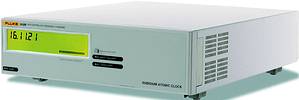

The Fluke 910 and 910R are new cesium-controlled frequency standards that use GPS technology and connectivity to provide primary standard traceability from any location. Delivering a precision frequency and time reference, they can be installed, monitored and managed from virtually any location. Both models receive their long-term frequency stability from the built-in cesium standards in the GPS satellite array, yet can also provide a very high short-term stability from the built-in oven controlled crystal oscillator (OCXO) or rubidium standard (Rb).
There are two standard models; the very-high stability 910R with built-in rubidium atomic clock, and the affordable 910 with a high stability local oven controlled crystal oscillator. Both are fully traceable, extremely accurate frequency standards and are well suited for use as frequency standards in many applications, including telecommunications, calibration and automatic test systems.
According to the manufacturer, off-air frequency standards have existed for several years. But until now, they all have had the same internal architecture. The unit is, in effect, a 'black box,' with an antenna input and a frequency output. The local oscillator's control process (disciplining) is hidden from the user. Typically, users have used another frequency reference (for example, a rubidium standard), a timer/counter and a PC for logging the deviation between the 'black box' and the frequency reference. The concept of traceability requires an unbroken chain of comparisons to international standards, on a continuing basis, where all comparisons produce documented results with stated uncertainty. Now, for the first time says Fluke, a documenting frequency comparator and a very stable secondary standard are united within the same instrument together with the GPS receiver. The received GPS signal is measured continuously against the local oscillator. Phase and frequency deviation is stored internally and can at any time be transferred to any PC directly from the 910/910R or, via the optional Ethernet interface, from or to almost anywhere. Then by using the GPSView software supplied with every model, a printout of the traceability record can be obtained. The unbroken calibration history chain (day by day) is maintained in the non-volatile memory for several years, with the current 24-hour mean offset being displayed continuously on the front panel's LCD display.
Both models come with one 5 MHz and five 10 MHz sinewave outputs as standard. A 1-pulse-per-second output is also included. If the application requires more outputs - for example, if several other instruments need to be supplied from the same frequency standard - option 70 allows for the mounting of five more 10 MHz outputs. Alternatively, option 72 allows for the expanding of the instrument to give five extra 2,048 MHz outputs, which is particularly useful in many telecoms applications. Option 73 provides five extra 13 MHz outputs, the standard frequency for GSM base station master clocks. Another variant on output configuration is offered through option 71, which gives the instrument an additional four sine wave outputs of 10 MHz, 5 MHz, 1 MHz and 0,1 Hz, plus a 0,1 MHz square wave output. And finally, option 75 allows one to define one's own pulse frequency output.
The GPSView software communicates with the GPS-controlled frequency standard. Its main purpose is to provide a traceable calibration document based on the internally stored 24-hour frequency offset values. The manufacturer says it is only necessary to download data to a PC to the 910/910R once every second year to obtain an unbroken traceability chain since first use. For performance analysis over a shorter period and for short-term phase variation, data can be obtained over the latest 40-day period.
For more information contact Hilton Preston, Spescom MeasureGraph, 011 266 1753, [email protected]

© Technews Publishing (Pty) Ltd | All Rights Reserved